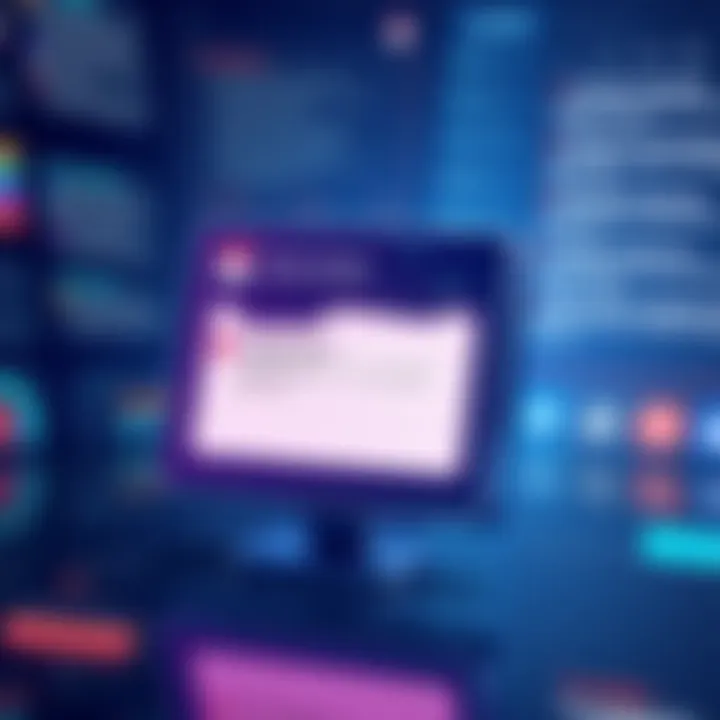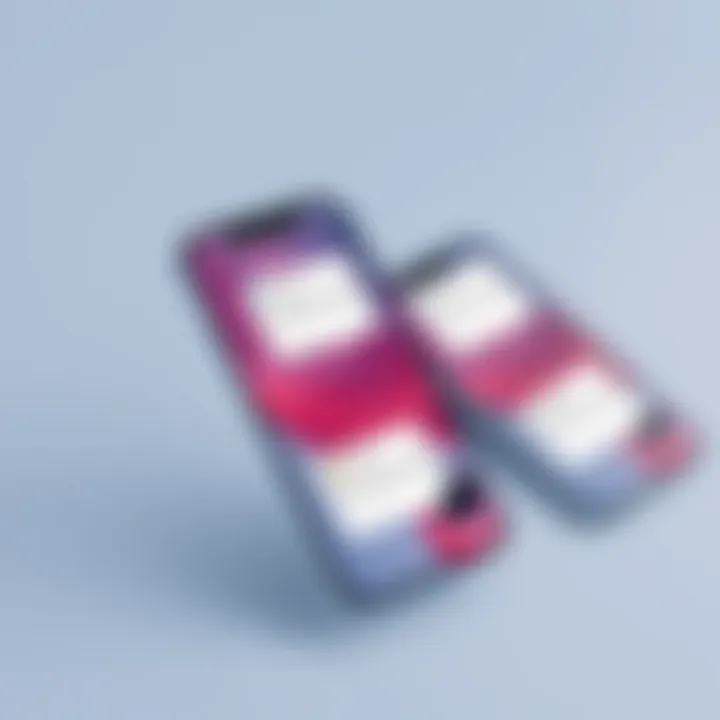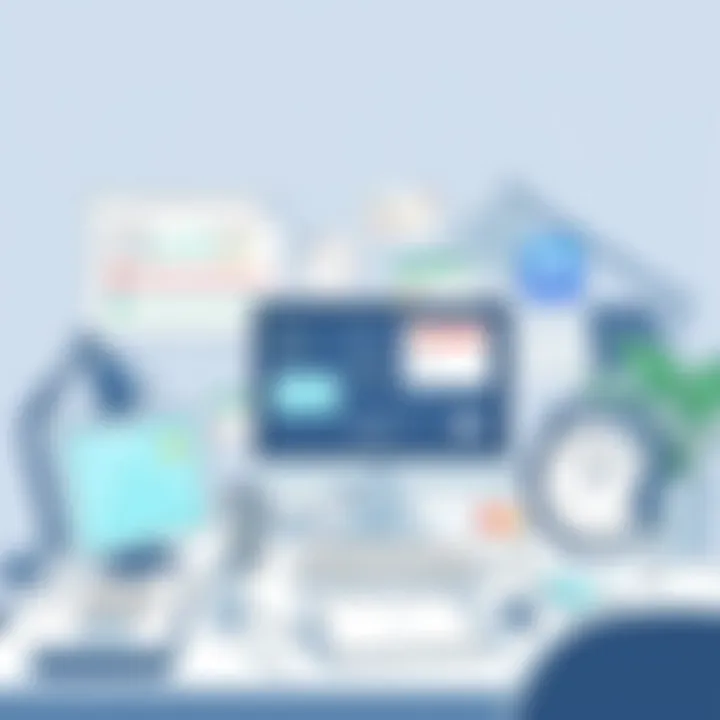Mastering Reminders in a Fast-Paced Digital World


Intro
In the whirlwind of modern life, keeping track of responsibilities can often feel like trying to catch smoke with your bare hands. The demands of work, family, and personal commitments make it easy to let tasks slip through the cracks. That’s where setting reminders comes in, a simple yet powerful tool that can help manage the chaos. In today’s digital landscape, technology offers a plethora of options for effective reminder systems, and understanding how to maximize these tools can fundamentally enhance your productivity.
Reminders come in various shapes and sizes, from simple alarms on your smartphone to sophisticated apps that can sync across multiple platforms. The significance of these reminders cannot be overstated; they enable individuals to organize their lives more effectively, ensuring that nothing critical is overlooked. This article will guide you through the available platforms for reminders, explore their features, and discuss how they can help optimize your time management strategies.
As we traverse this topic, we’ll pinpoint key aspects that make reminder systems so essential. This encompasses everything from the basic operation of reminder tools to their impact on productivity in both personal and professional settings. By the end, you'll be equipped not only with knowledge but also practical steps to harness reminders effectively in your everyday life.
Understanding the Importance of Reminders
In today’s fast-paced world, keeping track of our commitments, errands, and tasks can often feel like trying to catch smoke with your bare hands. Between work deadlines, family obligations, and personal goals, it's no surprise that many struggle to stay organized. This is where reminders come into play. They are not just simple nudges; they carry profound significance for cognitive functioning, emotional well-being, and effective time management.
Cognitive Benefits
Setting reminders serves not just as an external prompt but also fosters cognitive clarity. When individuals are bombarded with myriad tasks, it can lead to mental clutter. By establishing reminders, people free up their cognitive load significantly. This practice helps in the fine-tuning of one’s memory—it becomes easier to remember information without the incessant worry about forgetting appointments or deadlines. Studies have shown that when reminders are utilized effectively, they can enhance overall memory retention. Utilizing tools, such as apps and digital calendars, not only keeps tasks in sight but also helps to sharpen focus and mental agility.
- Reminders minimize the risk of forgetting important tasks.
- They structure day-to-day activities in a manageable way, allowing the mind to focus on creativity and critical thinking.
- Short-term memory is enhanced as a result of actively using reminders, which reinforces learning and information processing.
Emotional Impact
It's fascinating how much our emotional landscape relies on our organizational skills. When reminders are appropriately set, they diminish stress and anxiety. People often experience a sense of relief knowing that they won't overlook essential responsibilities. On the contrary, when reminders are ignored or ineffective, feelings of guilt and frustration can arise. This creates a cycle of negative emotions that can detract from overall productivity. A well-structured reminder system can instill a sense of accomplishment, empowering individuals to take charge of their lives. Remembering anniversaries, deadlines, and important dates through reminders fosters connection and shows people that they matter, thus enhancing overall emotional health.
“Reminders are like little lifebuoys in a stormy sea of commitments.”
- Enhanced emotional stability leads to improved focus on tasks.
- Regularly receiving reminders can build familiarity and comfort with scheduling.
- Emotional well-being is reinforced when reminders allow individuals to maintain their commitments, reducing stress.
Time Management Enhancement
When it comes to managing time efficiently, reminders are cornerstone elements that can facilitate this process. They act as the glue that binds various commitments and activities together, ensuring that nothing falls through the cracks. Through dissecting one's to-do list into smaller, manageable chunks, reminders can help individuals stay on track. This practical application keeps procrastination at bay, enabling more disciplined approaches to time management.
- Integrating reminders into daily routines transforms chaos into order.
- Utilizing features from digital tools, such as priority settings in reminder systems, can yield significant efficiency gains.
- Being consistent with reminders cultivates habits that lead to more productive workdays.
In summary, understanding the importance of reminders is pivotal for anyone seeking to navigate the complexities of modern life. The cognitive benefits, emotional stability, and time management enhancements derived from effective reminder systems are not just minor perks; they are essential skills that contribute to one’s overall quality of life.
Technological Tools for Setting Reminders
In the fast-paced world we navigate today, technological tools play a crucial role in managing our time and obligations. The vast array of options available can either simplify our lives or leave us mired in confusion. It’s important to approach the landscape of reminder technologies with an understanding of how they can be tailored to individual needs. This section will break down various resources from applications to built-in smartphone features and wearable technology, illustrating how they contribute not just to efficiency, but to the overall enhancement of productivity.
Applications Overview
In recent years, the digital marketplace has seen an explosion of various reminder applications. Services like Todoist, Any.do, and Microsoft To Do are tailored for diverse user needs. These tools are far from one-size-fits-all solutions; rather, they enable distinct functionalities that adapt to personal workflows.
Benefits of these applications include:
- Customizability: Users can often personalize reminders according to their preferences. Whether it’s a recurring meeting or a one-off event, the ability to set custom notifications allows for deeper engagement.
- Integrations: Many applications sync seamlessly with calendars, emails, and other platforms. This helps consolidate tasks, ensuring nothing slips through the cracks.
- Intuitive Interfaces: Most modern applications offer user-friendly designs. They engage users with simple navigation and clear visual indicators for tasks.
The takeaway is simple—these applications don’t just help users remember tasks; they create an ecosystem. They act as digital assistants, transforming a daunting to-do list into manageable chunks, thus allowing for a more productive day.
Built-in Smartphone Features
Smartphones have evolved into all-encompassing devices that integrate powerful reminder functionalities right out of the box. The reminder features built into iOS and Android systems serve as a reliable backbone for daily planning. With options like Google Assistant or Siri, users can set reminders using voice commands, making the process hands-free and immediate.
Considerations when using built-in features:


- Accessibility: Since most users carry their smartphones at all times, this type of reminders ensures you have access no matter where you are.
- Notification Management: The advanced settings of these built-in features allow users to control how and when notifications are received, helping to strike a balance between being alerted and being overwhelmed by constant reminders.
These smartphone features demonstrate that sometimes, the most effective tools are already at your fingertips. They streamline the reminder process, blending seamlessly into the user's routine.
Wearable Technology Integration
The rise of smartwatches and fitness bands has brought a new dimension to reminder systems. Devices like the Apple Watch and Fitbit not only track health metrics but also play an integral role in time management. They provide haptic feedback for reminders, nudging users without the need for a visual or auditory notification that might distract or disturb others.
Key elements of wearable technology include:
- Proximity Alerts: Users can receive notifications within specific locations, like being reminded to pick up groceries when nearby shopping areas.
- Health-focused Reminders: Wearables often encourage you to stand up or take a breather, melding health with practicality in reminders.
- Often Always On: These devices are in constant connection with smartphones, ensuring reminders are immediately passed along, reinforcing the original intention.
In essence, wearables have redefined how reminders manifest in our lives, promoting healthier habits while ensuring that important tasks don't fall through the cracks.
As we explore the technological tools available for reminders, it's clear that they are more than mere prompts. They are sophisticated systems that empower individuals to take control of their time, aligning personal and professional schedules. The next sections will delve deeper into how these technologies interact with user productivity and the inherent challenges they bring.
Setting Effective Reminders
Setting effective reminders is a cornerstone of time management in an era where distractions and competing demands vie for our attention. The importance lies not just in the act of remembering; it’s about creating a system that enhances productivity and efficiency. Throughout daily life, we juggle appointments, deadlines, and personal obligations. A thoughtfully crafted reminder system can mean the difference between smoothly navigating a busy schedule or feeling overwhelmed and lost.
Choosing the Right Method
Selecting the right method for setting reminders can significantly affect how well they serve their purpose. It’s important to start by assessing personal preferences and habits. Do you prefer high-tech solutions or low-tech approaches? Here are several methods to consider:
- Mobile Apps: Platforms like Todoist and Microsoft To-Do can help organize tasks and set reminders based on specific deadlines.
- Voice Assistants: Utilizing Siri, Alexa, or Google Assistant streamlines the process by allowing users to set reminders through voice commands, often hands-free.
- Sticky Notes: Sometimes the analog approach works best. A colorful sticky note placed on a desk or computer can provide a tactile reminder that digital options can’t replicate.
Choosing the wrong method may lead to frustration or missed reminders. It is essential to experiment with different systems until one feels intuitive, balancing between function and personal preference.
Timing Considerations
Timing is crucial when it comes to setting reminders. A reminder that pops up too early may be ignored, while one that appears too late can render it ineffective. Consider these factors:
- Urgency of Task: For instance, if you have a meeting at 3 PM, setting a reminder for one hour prior can ensure you're prepared. But if it’s something low priority, a reminder for the day before might suffice.
- Schedule Compatibility: Align your reminders with your routine. If you're a morning person, schedule reminders earlier in the day when you're likely to be most productive.
One effective tactic is the implementation of the "two-minute rule." If a task can be completed in two minutes upon receiving the reminder, do it immediately. This not only clears tasks off your list but also bolsters motivation.
Personalizing Reminders for Efficiency
Personalization of reminders is key to making them resonate. Rather than just setting a generic alert, adding a personal touch can increase their effectiveness. Consider these aspects to personalize reminders:
- Use Specific Language: Instead of "Meeting at noon," try "Prepare for client call with Jane at noon." This specificity helps cement the action needed in your memory.
- Incorporate Contextual Information: Reference the location or urgency. For example, "Buy groceries at 5 PM after work" offers clarity that a simple "Buy groceries" does not.
- Visual or Auditory Elements: Adding special sounds for different types of reminders or even color-coding tasks can enhance cognitive recognition.
Adding these elements personalizes the reminder experience, turning a simple alert into an integral part of your scheduling strategy. The smarter the reminder, the less likely it is to be just another notification in an overflowing digital world.
Personalizing reminders not only improves recall but also fosters accountability for the tasks at hand.
Exploring Reminder Systems
In today’s fast-paced world, the way we manage our tasks and commitments is pivotal for staying organized and productive. Exploring reminder systems allows us to leverage various tools and platforms, ensuring we don’t lose sight of what truly matters amidst our busy routines. By integrating effective reminder systems into our daily lives, we can streamline tasks, create habits, and ultimately enhance our overall efficiency.
Digital Calendar Platforms
Digital calendar platforms have become indispensable in how we manage time. Whether it's Google Calendar, Microsoft Outlook, or Apple Calendar, these tools often provide intuitive interfaces that ease scheduling and set reminders. The benefits of utilizing such platforms include:


- Synchronization across devices: Having access to your calendar from your smartphone, tablet, and computer ensures you never miss an important date or task.
- Event sharing capabilities: Many calendar tools allow you to share events with others, making it simpler to coordinate meetings or social gatherings.
- Customizable notifications: You can tailor alerts to remind you well ahead of time, preventing those last-minute scrambles that often cause stress.
Imagine receiving a reminder on your smartphone moments before a meeting starts. This integration of notifications ensures you’re always prepared, allowing for smoother transitions between tasks throughout the day.
Task Management Tools
Task management tools, such as Trello, Asana, or Todoist, provide a robust framework for managing projects and individual tasks. These systems allow for not just setting reminders but also prioritizing work based on urgency and importance. Some key aspects include:
- Visual boards and lists: These platforms often feature visual aids that help you track the progress of tasks easily.
- Collaborative features: Task management tools frequently allow teams to collaborate, assign tasks to individuals, and maintain visibility on each other’s responsibilities.
- Integration with other tools: Most task managers integrate seamlessly with email and calendar systems, creating an ecosystem that consolidates all your commitments.
By using a task manager effectively, one can transform chaotic lists into organized action items, thus minimizing anxiety around deadlines.
Email and Messaging Reminders
Email and messaging platforms also offer useful reminder functionalities that many users overlook. Services like Gmail and Slack can be configured to send reminders for important emails or tasks assigned. Consider these benefits:
- Ease of access: Since people check their emails frequently throughout the day, reminders sent via email or messaging platforms can be highly effective; they reach you where you already are.
- Integration with other systems: Often, reminders can be created directly from an email or a message, making it convenient to turn conversations into actionable tasks.
- Reminders based on keywords: Some systems allow for reminders triggered by specific keywords or phrases, enhancing the personalization of your reminders.
By weaving reminders into communication tools, you maximize their accessibility, ensuring no important detail slips through the cracks.
"Staying organized means staying ahead. Use the tools at your fingertips to conquer your calendar and tasks with confidence."
Challenges in Setting Reminders
In the quest for better time management and enhanced productivity, setting reminders often emerges as a valuable strategy. However, it’s not all smooth sailing. Various challenges can complicate the act of establishing efficient reminders. Understanding these challenges is essential for effectively navigating them and optimizing the reminder-setting process.
Overload of Notifications
In an age where our devices sound off like impatient car horns, the flood of notifications can quickly become overwhelming. It’s nearly impossible to sift through the cacophony to discern which reminders are genuinely important. Often, people find themselves in a dilemma; they tune out all notifications, including crucial alerts.
It has been observed that the more notifications one receives, the less they focus on the ones that matter most. A 2021 study conducted by The International Journal of Human-Computer Interaction illustrates that constant interruptions undermine concentration and task completion. The challenge isn't just remembering a task but also distinguishing it from the digital noise around it.
"It’s all about finding balance; too much noise leads to tuning out the signals."
Technological Dependence
Relying heavily on technology for reminders can come with its own set of pitfalls. While email alerts, smartphone notifications, and task management apps exist to simplify our lives, an over-reliance can prove detrimental. How often have you glanced at your device, only to find it unresponsive?
Technical issues can strike at the most inopportune times, from battery failures to software glitches. If someone is banking on digital reminders and their device dies or an app crashes, their plans may go awry. Additionally, an all-consuming dependence on technology can lead to complacency; when the devices do not alert us, we may forget our tasks altogether. Adapting a hybrid approach, combining digital and analog reminders, might mitigate the risks associated with technological over-dependence.
Ignoring Reminders
Another hurdle in the reminder-setting landscape is the tendency to ignore notifications altogether. This is not just about dismissing an alert—it's a behavioral phenomenon that encompasses everything from electronic fatigue to simply feeling overwhelmed by the sheer volume of reminders.
As reminders pile up, individuals may inadvertently tune them out, leading to missed deadlines and neglected responsibilities. A study from Harvard Business Review indicates that individuals often mark reminders as "read" without acting on them. The brain wires itself to overlook what it frequently encounters. This complacency can create a snowball effect where missed reminders become a consistent issue, further complicating time management and productivity.
The Intersection of Reminders and Productivity
In our fast-paced world, the need to enhance productivity through effective time management is paramount. Reminders serve as the bridge connecting our everyday tasks with our larger goals. They are not merely notifications buzzing on our devices; they represent a structured approach to navigating our increasingly busy lives. Let's delve deeper into how setting reminders can power our productivity and ultimately influence the quality of our work and personal lives.
Productivity Frameworks
A framework is a set of rules and guidelines intended to streamline processes. In the productivity realm, various strategies intertwine with reminders to create effectiveness. For example, the Getting Things Done (GTD) method emphasizes capturing tasks in a manageable system, clearly resonating with how reminders can structure one's workload. When you set a reminder to review your tasks weekly, you essentially ensure that nothing slips through the cracks.


Using frameworks allows individuals to categorize reminders based on urgency and importance, leading to a clearer path forward. One might say that reminders act like traffic lights in a bustling city, guiding individuals through their day by prioritizing what needs immediate attention versus what can wait.
For those who thrive on structure, employing the Eisenhower Matrix—separating tasks into four quadrants based on urgency and importance—can amplify the power of reminders. When emergencies arise, reminders help you switch gears more fluidly, keeping priorities aligned with broader goals.
Balancing Work and Personal Life
Striking a balance between professional obligations and personal endeavors can be a tightrope walk, and reminders are your safety net. When obligations pile up, and personal time dwindles, reminders can anchor your time and help you dedicate moments to recharge.
It’s easy to get caught in the whirlwind of work, forgetting to pause and take care of oneself. By setting reminders for personal activities—be it a workout session, family dinner, or even just a quiet coffee break—you create boundaries that facilitate balance.
Furthermore, studies show that people who actively remind themselves to take breaks often report increased levels of satisfaction and reduced stress. With technology that allows us to set reminders with geographic tags—such as prompting us to meditate when we arrive home from work—integrating productivity and personal wellness becomes seamless.
A well-crafted reminder can serve as a gentle nudge, encouraging you to step away from your computer or resist the allure of yet another late-night email. It ensures you give yourself time to recharge, boosting overall productivity when you return to your tasks.
In this age of constant connectivity, that balance is not merely a luxury; it's an essential strategy for sustained productivity. Integrating reminders within productivity frameworks not only creates better organization of duties but enhances overall well-being, a key ingredient in long-term success.
Not all reminders are created equal; customizing them to suit specific personal or professional goals can lead to significant improvements in productivity and satisfaction.
Embracing the intersection of reminders and productivity means recognizing their role as vital tools. They remind us to focus, strategize, and take breaks—all while helping us keep our eyes on the prize. With the right approach, these tools can ensure that no task is too daunting and no goal is out of reach.
Future of Reminder Technologies
As we navigate the complexities of modern life, the significance of reminders has taken on a whole new dimension. They are no longer just a simple nudge to remember a meeting or a birthday. The landscape of reminder technologies is evolving rapidly and influences how we manage our time and tasks. This evolution holds particular importance in a world where distraction and information overload are rampant.
Emerging technologies are reshaping our understanding and execution of reminders, offering tools that are more intuitive, smart, and, ultimately, beneficial for productivity. It's not just about keeping our schedules; it’s about enhancing our overall quality of life, ensuring we don’t drop the ball in an age where the pressure to perform is ever-increasing.
Artificial Intelligence Integration
With Artificial Intelligence gaining ground, the way we set and manage reminders is changing, providing a tailored experience that reflects our habits and preferences. AI-driven reminders can now adapt to the user’s behavior. For instance, if you frequently ignore reminders to go for a walk, an AI system might learn from this and adjust the frequency or the timing of such prompts.
- AI can analyze your calendar, suggesting optimal times for tasks based on your historic efficiency.
- Some platforms leverage predictive technologies that understand your working patterns, allowing them to propose reminders in advance of your deadlines.
This further enhances focus and productivity, cutting through the noise of unnecessary alerts and prioritizing what is genuinely important. More importantly, integrating AI into reminder systems goes beyond simple task management—it can even enhance collaboration. By analyzing team dynamics and workflows, these systems can suggest reminder syncs for group tasks and deadlines.
Evolution of Wearable Devices
Wearable technology has carved a niche in personal productivity. Devices like smartwatches and fitness trackers now come equipped with advanced reminder systems that go beyond mere notifications. They have transformed the way we interact with our tasks throughout the day.
- Persistent and context-aware reminders are one of the standout features. For example, if your watch senses you’ve been sitting for too long, it might remind you to stand up and stretch—essential in our predominantly sedentary lifestyles.
- These gadgets can use location-based reminders as well. If you're near a grocery store, your device can remind you to pick up items on your shopping list, taking away the mental load of remembering such tasks.
Beyond these practical implementations, the evolution towards seamless integration between multiple devices offers a unified reminder experience, where notifications can flow fluidly from your phone to your watch. Advanced developments in this field promise even greater interactivity and personalization in the future. The blend of AI with wearable tech fosters a more natural approach to reminders, making them less intrusive yet still effective.
"The future of reminders is not just about remembering tasks—it's about living smarter."
Finale
The role of reminders in our daily lives cannot be overstated. In a world where tasks pile up and distractions abound, understanding how to leverage reminders is essential for almost anyone. Throughout this article, we've highlighted key insights into not just the mechanics of setting reminders but their broader implications on our productivity and stress levels.
Summarizing Key Insights
- Cognitive Load Reduction: Reminders significantly help reduce cognitive strain. When you have a tool that keeps tasks organized, you free up mental space for other important decisions and ideas. This serves as a cornerstone for achieving mental clarity.
- Emotional Well-Being: Stress often arises from uncertainty and worry about forgetting tasks. A well-structured reminder system provides reassurance. This emotional benefit shouldn't be underestimated, as it directly contributes to a healthier mindset.
- Time Management Mastery: As we've explored from digital calendars to task management tools, reminders can streamline your day-to-day activities. The ability to set timely alerts ensures that nothing slips through the cracks and time is spent wisely.
- Integration of Technology: With advancements such as artificial intelligence taking the lead, we see an evolution in how reminders function. These technologies promise not only to notify but to suggest priorities, making them indispensable tools for the modern-day professional.
- Productivity Enhancement: Finally, reminders serve a crucial role in productivity frameworks. They allow individuals to balance both personal and professional responsibilities, ultimately leading to a more satisfying life.
Encouraging Strategic Reminder Use
To truly benefit from reminders, it isn’t enough to simply set them. It’s important to adopt a strategic approach:
- Set Clear Objectives: Define what you want to achieve through reminders. Be it project deadlines or personal goals, clarity will guide your approach.
- Customize Alerts: Use specific tones or messages that resonate with you. A cheerful chime versus a stern buzz can change your emotional response, influencing your motivation.
- Regular Review: Take time to assess the effectiveness of your reminders. Are they contributing positively to your workflow? Adjust as necessary.
- Embrace Technology: Be open to exploring new tools that may enhance your reminder system. From apps that seamlessly sync across devices to smart assistants that learn your habits, technology can offer significant advantages.
In a world where relentless demands can lead to chaos, mastering reminders has become not just beneficial but necessary. By implementing a thoughtful approach to reminders, individuals can navigate the complexities of modern life more effectively. Embrace the opportunities that arise with effective reminder usage, and transform potential chaos into structured tranquility.

